In today's rapidly evolving digital landscape, businesses face unprecedented challenges with payment processor integration and ensuring seamless website functionalities across all platforms. As artificial intelligence transforms how we handle financial transactions and mobile payment gateway adoption accelerates, comprehensive payment testing has become crucial for maintaining site functionality and customer trust.
Modern payment systems must navigate complex user interface testing requirements while ensuring robust credit card validation processes. With the rise of social media commerce and changing data centers infrastructure, businesses need thorough compatibility testing to guarantee their payment solutions work flawlessly across different environments.
Whether you're managing simple transactions or complex multi-currency payments, effective payment testing protects your revenue streams and enhances customer experience. This comprehensive guide explores essential payment testing methods, security protocols, and real-world scenarios that every business should implement to stay competitive in the digital marketplace.
What’s Next? Keep reading to discover:
🚀 Essential Payment Testing Types - Functional, security, usability, and integration testing methods
🚀 Step-by-Step Testing Process - Systematic approach from setup to validation across devices
🚀 Manual vs. Automated Strategies - When to use automated tools vs. manual testing
🚀 Real-World Testing Scenarios - E-commerce, subscriptions, mobile apps, and marketplace cases
🚀 Expert Testing Solutions - AI-driven automation services and cloud-based infrastructure
What Is Payment Testing?
Payment testing is a crucial process that ensures online payment systems function correctly and securely. It involves verifying how payment methods handle real transactions, from credit card payments to digital wallets.
Key aspects of payment testing include:
- Functionality verification: Ensuring all payment features work as designed
- Security validation: Protecting customer financial data during transactions
- Performance monitoring: Confirming systems handle transaction volumes efficiently
- User experience testing: Making sure customers can complete purchases easily
Payment testing covers multiple online payment methods including credit cards, PayPal, Apple Pay, and bank transfers. It helps businesses identify issues before customers encounter them, maintaining trust and preventing revenue loss.
The process involves both automated and manual testing approaches. Teams test various scenarios from successful transactions to error handling, ensuring the entire payment ecosystem works smoothly across different devices and browsers.
Payment Testing vs. Payment Gateway Testing
Many businesses confuse payment gateway testing with comprehensive payment testing, but they serve different purposes.
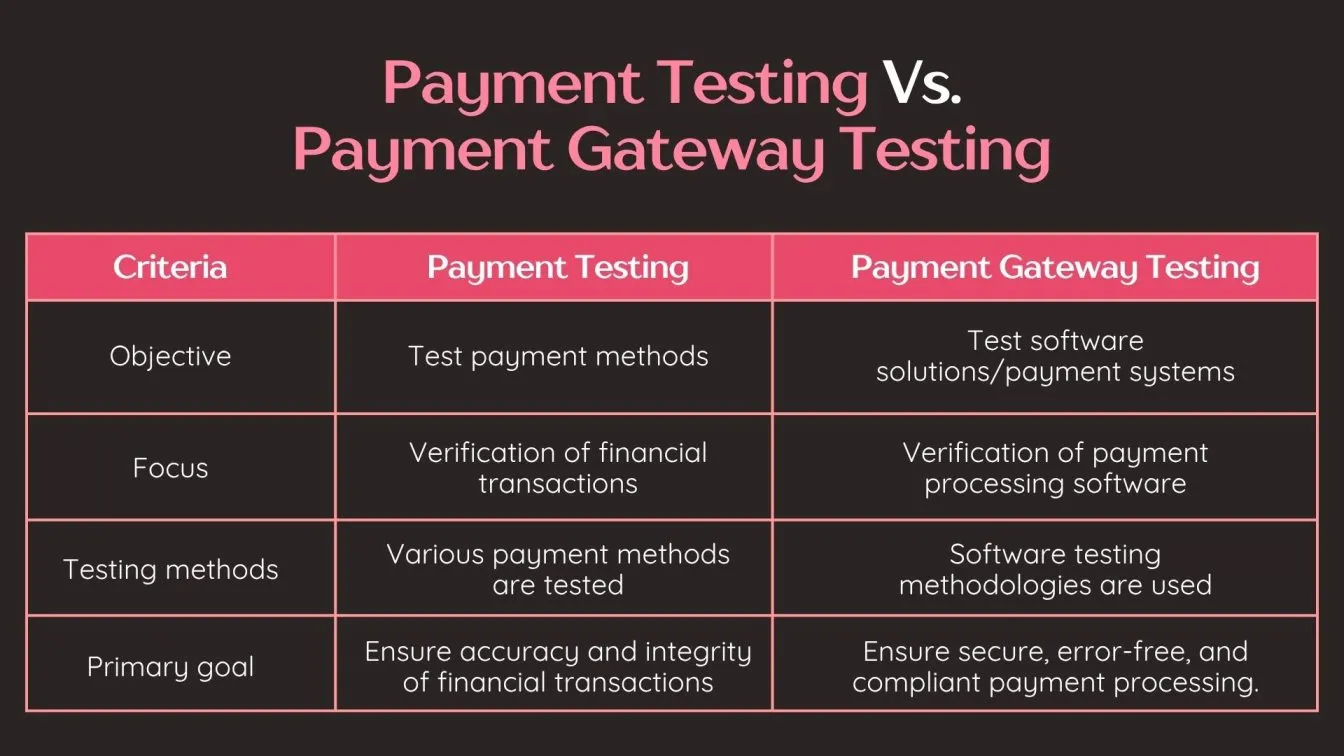
Payment Gateway Testing focuses specifically on:
- Authorization and settlement processes
- Communication with banks and financial institutions
- Transaction approval and decline handling
- Gateway-specific error responses
Complete Payment Testing covers:
- Entire user checkout experience
- Multiple payment methods integration
- User interface and form validation
- End-to-end transaction flows
- Cross-browser and mobile compatibility
Gateway-only testing might miss critical issues like poor usability testing, slow loading times, or integration problems with your website. Comprehensive payment testing includes functional testing, security testing, and user experience validation.
The best approach combines both gateway testing and full payment system testing to ensure technical functionality and optimal customer experience.
The Rise of New Digital Payment Methods
The payment landscape has evolved dramatically, moving beyond traditional credit cards to diverse online payment methods.
Popular Digital Payment Options:
- Digital wallets (Apple Pay, Google Pay, Samsung Pay)
- Buy-now-pay-later services (Klarna, Afterpay)
- Cryptocurrency payments
- QR code payments
- Bank transfers and ACH payments
- Regional payment methods (Alipay, WeChat Pay)
This diversity creates new challenges for payment testing teams. Each payment method requires specific testing approaches, user flows, and security considerations.
Testing Considerations:
- Mobile-first payment experiences
- Localization testing for regional payment methods
- Cross-platform compatibility
- Integration with multiple payment providers
- Security requirements for each payment type
Businesses must prioritize testing the payment methods their customers actually use, which may vary by region, demographics, and industry. Staying current with emerging payment technologies is essential for comprehensive testing strategies.
Key Payment Testing Types You Should Know
Effective payment testing requires multiple specialized approaches to ensure comprehensive coverage of all payment scenarios.
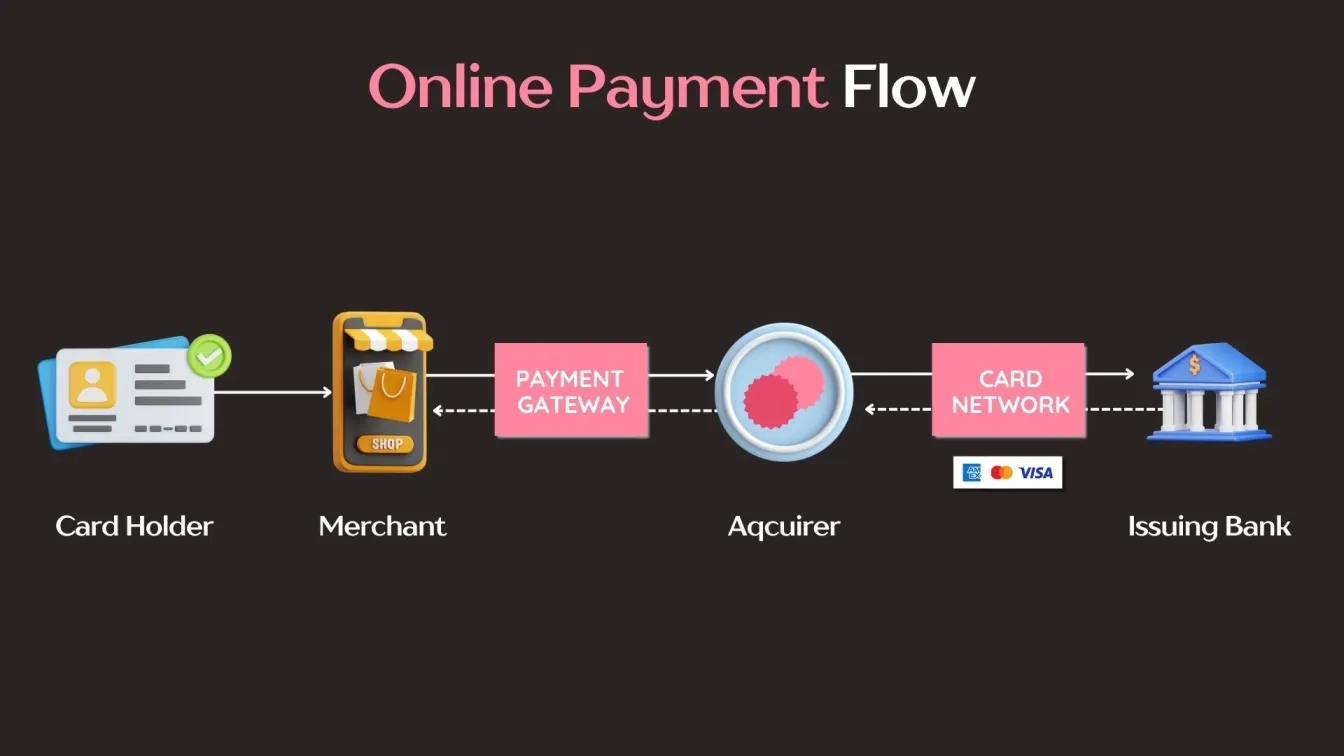
Payment Functional Testing
Functional testing in software testing verifies that payment features work according to specifications and business requirements.
Core Testing Areas:
- Transaction processing (successful payments, declines, refunds)
- Payment form validation and error handling
- Currency conversion and tax calculations
- Payment method switching and selection
Automated functional testing tools help streamline repetitive test cases, while manual testing handles complex scenarios. Software functional testing for payments includes edge cases like expired cards, insufficient funds, and network timeouts.
QA functional testing teams create comprehensive test suites covering normal workflows and unusual situations. Functional testing tools enable continuous validation of payment features during development cycles.
Payment Security Testing
Security testing protects sensitive financial data and prevents unauthorized access to payment systems.
Essential Security Testing Types:
- Web application security testing: Scanning for vulnerabilities like SQL injection
- Security penetration testing: Simulating real attack scenarios
- API security testing: Protecting payment gateway communications
- Network security testing: Ensuring secure data transmission
Security testing tools automate vulnerability scanning and compliance checks. App security testing and web security testing address platform-specific security concerns.
Manual security testing complements automated tools by examining complex attack vectors. Regular security assessments help maintain PCI DSS compliance and customer trust.
Payment Performance Testing
Performance testing ensures payment systems handle expected transaction volumes without degrading user experience.
Key Performance Metrics:
- Transaction processing speed
- System response times under load
- Concurrent user capacity
- Database query performance
Load testing simulates high-traffic scenarios like holiday sales or flash promotions. Performance testing identifies bottlenecks that could cause payment delays or system crashes.
Mobile performance testing is crucial since many customers use smartphones for purchases. Testing must account for varying network speeds and device capabilities to ensure consistent payment experiences.
Payment Integration Testing
Integration testing verifies that payment system components communicate correctly with each other and external services.
Integration Testing Focus Areas:
- API integration testing: Ensuring smooth communication with payment gateways
- Continuous integration testing: Automated testing during development
- Third-party service integration: Connecting with banks and processors
Testing in continuous integration environments catches integration issues early. Payment systems often rely on multiple APIs, databases, and external services that must work together seamlessly.
Integration testing also covers business system connections like inventory management, customer databases, and accounting software to ensure data consistency across platforms.
Payment Usability Testing
Usability testing focuses on customer experience and ease of use during the payment process.
Usability Testing Components:
- Website usability testing: Desktop checkout experience optimization
- Mobile usability testing: Smartphone and tablet payment flows
- User testing payment: Real customer feedback on payment processes
Usability testing tools track user behavior, identifying friction points in checkout flows. Usability testing UX principles help create intuitive payment experiences that reduce cart abandonment.
Usability testing software enables A/B testing of different payment form designs, helping optimize conversion rates through data-driven improvements.
Payment Negative Scenario Testing
Negative scenario testing examines how payment systems handle errors, failures, and edge cases.
Common Negative Test Scenarios:
- Expired or invalid credit cards
- Insufficient account funds
- Network connectivity issues
- Payment gateway downtime
- Invalid form data submission
This testing ensures customers receive clear error messages and can easily recover from payment problems. Negative testing builds system resilience and improves customer satisfaction by handling failures gracefully.
Edge case testing covers unusual situations like extremely large payments, special characters in names, or payments from restricted locations to ensure robust error handling.
How to Test Payment Functionality: Step by Step
Testing payment functionality requires a systematic approach to ensure comprehensive coverage of all payment scenarios and user flows.
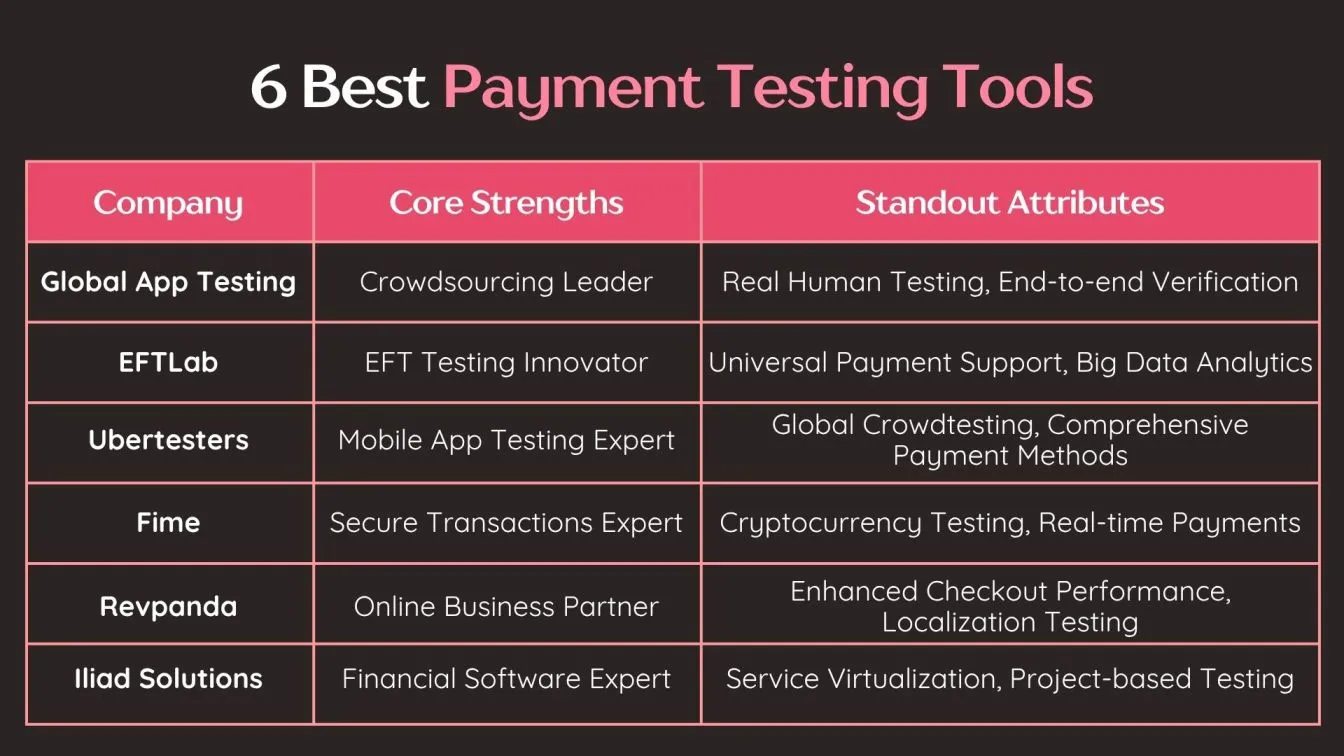
Step 1: Environment Setup
- Configure test payment gateways and sandbox environments
- Set up test credit cards and payment method accounts
- Prepare test data for various payment scenarios
Step 2: Functional Testing Execution
- Test successful payment processing with different payment methods
- Verify payment form validation and error handling
- Check refund and cancellation workflows
- Validate currency conversion and tax calculations
Step 3: Security and Integration Validation
- Perform web application security testing on payment forms
- Test API integration with payment gateways
- Verify data encryption during transmission
- Conduct network security testing
Step 4: User Experience Testing
- Execute usability testing across different devices
- Test mobile payment functionality on smartphones and tablets
- Validate checkout flow optimization
- Perform user testing payment processes with real scenarios
This structured approach ensures thorough coverage of payment testing requirements while maintaining quality and security standards.
Manual vs. Automated Payment Testing: Pros & Cons
Both manual and automated approaches play crucial roles in comprehensive payment testing strategies, each offering unique advantages for different testing scenarios.
Manual Payment Testing Benefits:
- Exploratory testing: Discovering unexpected issues through human intuition
- Usability testing: Evaluating user experience and interface design
- Complex scenario testing: Handling edge cases requiring human judgment
- User testing payment: Gathering real customer feedback on payment flows
Automated Payment Testing Advantages:
- Automated functional testing: Consistent execution of repetitive test cases
- Continuous integration testing: Rapid feedback during development cycles
- Regression testing: Efficiently validating existing functionality after changes
- Load testing: Simulating high-volume payment processing scenarios
Best Practice Approach:
- Use automated testing for routine functional testing and regression checks
- Apply manual testing for usability testing, exploratory scenarios, and complex user journeys
- Combine both approaches for comprehensive payment testing coverage
- Implement security testing tools alongside manual security penetration testing
The optimal strategy balances automation efficiency with manual testing insights to achieve thorough payment system validation.
Real-World Payment Testing Use Cases
Understanding practical payment testing scenarios helps businesses identify potential issues and improve their online payment systems effectively.
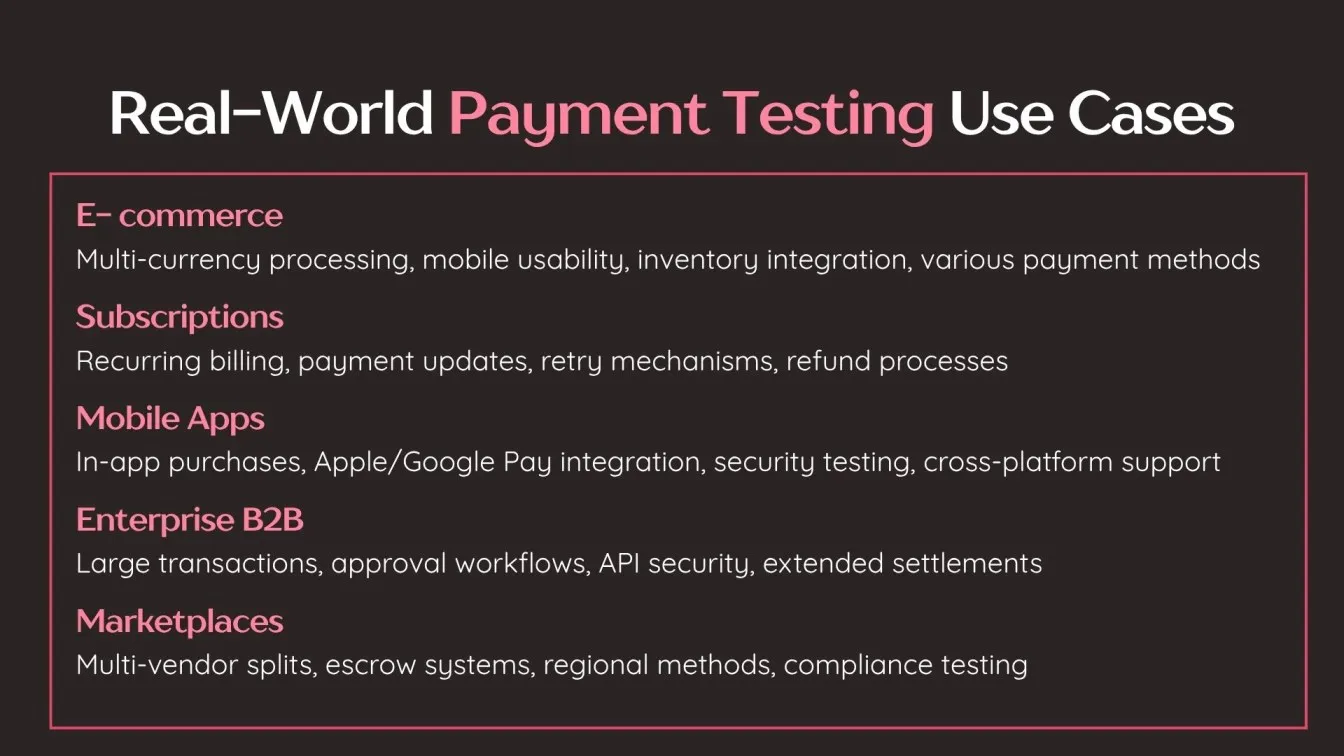
E-commerce Platform Testing:
- Multi-currency payment processing for international customers
- Integration testing with inventory management systems
- Mobile usability testing for smartphone shoppers
- Testing various online payment methods (cards, digital wallets, bank transfers)
Subscription Service Testing:
- Recurring payment processing and billing cycles
- Payment method update workflows
- Failed payment retry mechanisms
- Cancellation and refund processes
Mobile App Payment Testing:
- In-app purchase functionality
- Mobile payment integration (Apple Pay, Google Pay)
- App security testing for payment data protection
- Cross-platform payment compatibility
Enterprise B2B Payment Testing:
- Large transaction amount processing
- Complex approval workflows
- API security testing for business integrations
- Process online payments with extended settlement periods
Marketplace Payment Testing:
- Multi-vendor payment splitting
- Escrow and dispute resolution systems
- Localization testing for regional payment methods
- Compliance testing for different regulatory requirements
These real-world scenarios demonstrate the importance of comprehensive payment testing across different business models and customer needs.
Wrapping up!
Payment testing has become essential for businesses operating in today's diverse digital payment landscape. From traditional credit cards to emerging cryptocurrency options, comprehensive testing ensures your payment systems deliver secure, reliable, and user-friendly experiences across all channels.
Effective payment testing combines multiple approaches - functional testing validates core features, security testing protects sensitive data, usability testing optimizes customer experience, and integration testing ensures seamless connectivity. The key lies in balancing automated functional testing for efficiency with manual user testing payment processes for real-world insights.
Whether you're running an e-commerce platform, subscription service, or enterprise marketplace, implementing robust payment testing strategies protects revenue, builds customer trust, and ensures compliance with industry standards. As online payment methods continue evolving, businesses must adapt their testing approaches to cover new technologies while maintaining the highest standards of security and performance.
Investing in comprehensive payment testing today safeguards your business's financial future and customer relationships tomorrow.
Why Frugal Testing?
Frugal Testing stands out as a leading SaaS application testing company specializing in comprehensive payment testing solutions. Our AI-driven test automation services ensure your payment systems are secure, functional, and user-friendly across all platforms. The services offered by Frugal Testing include end-to-end payment validation, security penetration testing, and usability optimization for seamless checkout experiences.
Our cloud-based test automation services provide scalable testing infrastructure that adapts to your business needs, whether you're processing simple transactions or complex multi-currency payments. With expertise in functional testing, integration testing, and real-world payment scenarios, Frugal Testing delivers reliable, cost-effective solutions that protect your revenue and enhance customer trust in your payment systems.
People Also Ask
👉How do third-party APIs affect payment workflows?
Third-party APIs serve as critical connectors between your payment system and external services like banks, payment processors, and fraud detection systems. Any API downtime, latency issues, or integration failures can disrupt the entire payment workflow, causing transaction delays or failures.
👉How to test a bad gateway?
Test bad gateway scenarios by simulating network timeouts, server errors, and API unavailability using testing tools or sandbox environments. Verify that your system displays appropriate error messages and provides recovery options for customers when gateway issues occur.
👉Can payment testing reduce chargeback rates and disputes?
Yes, comprehensive payment testing significantly reduces chargebacks by ensuring accurate transaction processing, proper error handling, and clear payment confirmations. Thorough testing also validates fraud detection systems and prevents duplicate charges that commonly lead to customer disputes.
👉What machine learning techniques can improve payment testing efficiency?
Machine learning algorithms can analyze historical transaction patterns to automatically generate relevant test cases and predict potential failure points. AI-driven testing tools can also optimize test execution by prioritizing high-risk scenarios and reducing manual testing efforts through intelligent automation.
👉How can you test subscription billing cycles?
Test subscription billing by creating automated test scenarios that simulate different billing frequencies, payment method updates, and retry mechanisms for failed payments. Validate that the system correctly handles prorations, cancellations, upgrades, and recurring payment processing across multiple billing cycles.



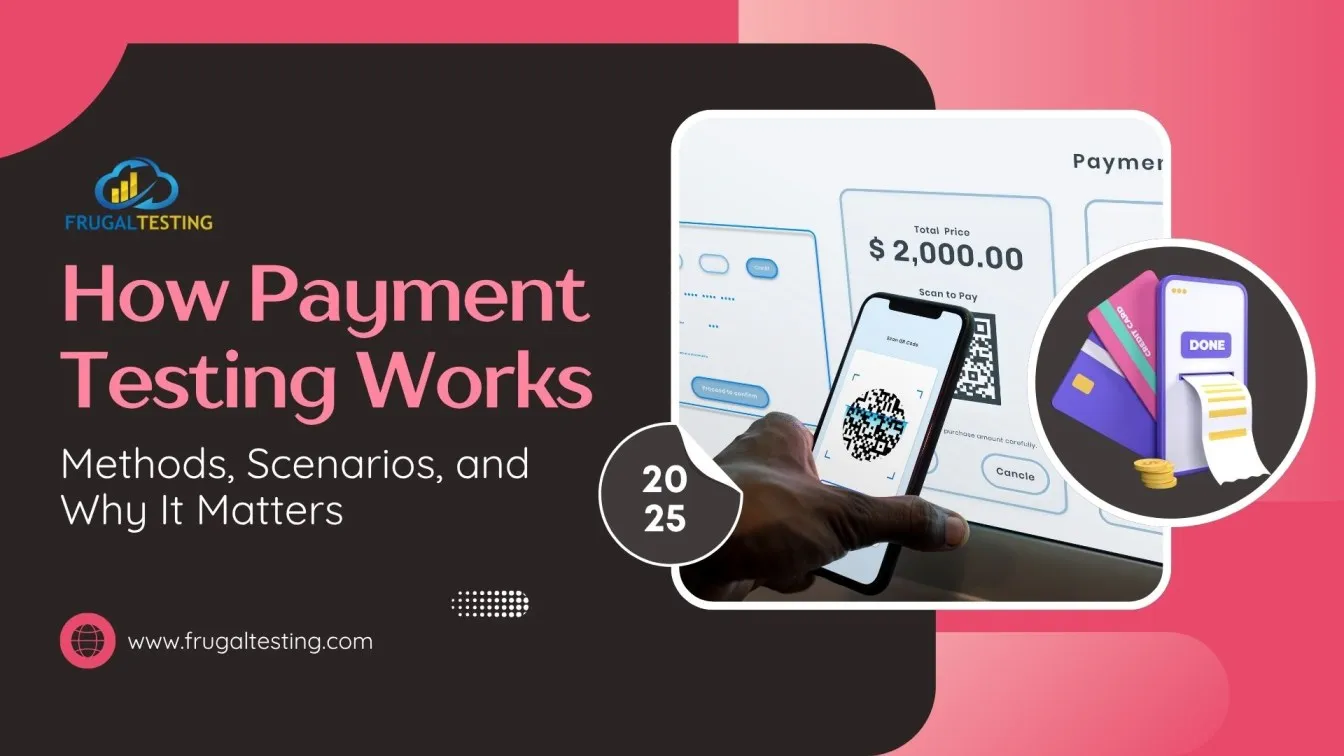

%201.webp)

